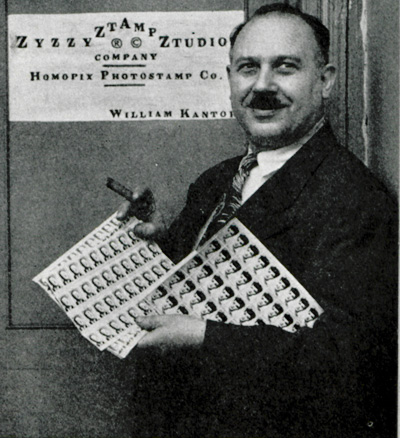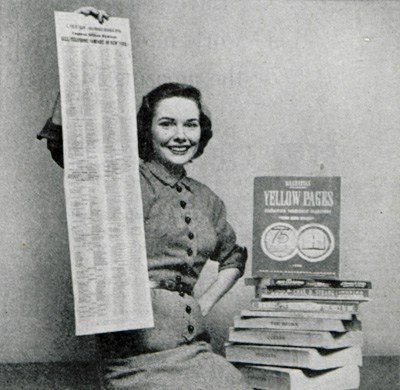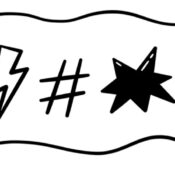Lo, the poor telephone book! Consider how its prestige has dimmed!
Once, it was the all-important guide to the city. Phone companies distributed their books everywhere, with a thoroughness that even the Gideons would admire.
It was the progenitor of search engines—your sole guide to the virtual world of telephones. It was how you found the number for muffler shops, the sanitation department, and that girl in your chemistry class. Every home and business received one updated copy every year, which was kept close by telephones, which, in those days, were leashed to the wall. By the time a directory was replaced, it would be dog-eared and tattered, bescribbled and bedoodled.
This week marks the anniversary of the first phone directory, issued in New Haven, Connecticut, on February 21, 1878. It listed the numbers of 11 homes, 38 businesses, and the Police Department. By 1910, America’s telephone books were keeping track of 7,000,000 phone numbers. Directories became even more important when automatic switching became widespread a few years later; allowing callers to find a number and dial their party directly without help from an operator.
In 1954 the Post printed “Sixty Million Headaches Every Year” by Henry and Katherine Pringle. It described how incredibly complex the task of producing America’s phone books was.
The chief headache, the Pringles explained, was hand-checking the accuracy of every name and number. Another challenge was distributing the massive volumes. A third was the immense costs of production. Bell Telephone executives estimated “the cost of publishing and delivering a directory the size of a Manhattan book is approximately $1.50.”
Scattered throughout the story of how phone companies updated and replaced directories are several historical details of interest.
“Otherwise civilized people have a deplorable habit of tearing out pages at booths and in hotel rooms instead of copying down the numbers. A staff of inspectors roam such busy centers as railroad and bus stations to see if directory replacements are necessary. At New York’s Grand Central Terminal fresh books are required every forty-eight hours. And nothing much can be done to stop people from tearing pages out of the directors for use as confetti when a parade is staged for some returning hero. A record was chalked up on Gertrude Ederle’s triumphant arrival to New York after she swam the English Channel in 1926. The shredded pages of 5,000 directories were showered on her at a cost, in those inexpensive days, of a couple of thousand dollars. The New York Telephone Company, which had to supply new books, still shudders at the memory.”
The Pringles quote “instructions for the proper use of instruments” in an early phone directory.
“‘When you are called from the Central Office, answer by ringing your bell the same number of times as your call, i.e., if your call is three, answer three: then turn the switch to the right and use your telephone. Speak clearly and distinctly, with your lips gently TOUCHING the telephone.’
“Instructions for use are less involved today, but they are still quite specific. The summer, 1953, directory for Cascade, Montana, lists only 182 names, but a word of warning inside the cover indicates that men are still men in the shadow of the Rocky Mountain:
“‘Profane or obscene language over the company’s wires is prohibited… Failure to observe this will constitute cause for discontinuing service.'”
The number of telephone books published each year has risen since 1954, as you might expect: from 60 million to 615 million. Even as Americans are turning to the Internet as their prime source of information, phone book producers are distributing more directories than ever before. Residents in most cities receive more than one set a year, broken into multiple volumes for neighborhoods. Often a new set arrives before the old set has been used.
There is a concern about the environmental affect of old telephone books. Heavy ink saturation on the pages, low-grade paper, and the glued binding prevent them from disintegrating like other paper products. Some recycling programs refuse to accept them. Yet the industry produces, according to a Louisville reporter’s calculation, over 1 million tons of phone books each year.

The Yellow Pages Association reports that business is good. All those millions of directories last year, they say, generated revenues of $13.9 billion, according to an article from slate.com. Slate’s reporter calculated “that’s more than $22 in revenue per copy. And, what’s more, those revenue figures are growing.”
Like direct-mail advertising, telephone books will continue to arrive at your address, unbidden, so long as they are profitable.
For additional information, check out these articles:
Louisville’s Disappearing Telephone Books by Thomas McAdam
The Book of the Undead: Why won’t phone books die? by Paul Collins
Become a Saturday Evening Post member and enjoy unlimited access. Subscribe now




Comments
I come from a long, ready line.
The year eighteen seventy eight,
The family craft that is mine
Began and continues to date.
Starting out in New Haven town,
The family spread forth worldwide.
Fingered for info, then put down,
But through it all we served with pride.
Though battered and then trashed for new
And younger more up to date kin,
And bashed for being un-green too.
It’s my purpose through thick and thin.
As your new phone book let me say
I’m here to flip through night and day.